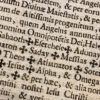by Ahmad al-Buni, Arabic manuscripts, 15th Century
Updated 06/04/2024
Shams al-Ma’arif (‘the Book of the Sun of Gnosis’) is a 13th-century grimoire written on Arabic magic and a manual for achieving esoteric spirituality. It was written by The Algerian scholar Ahmad al-Buni who was born in Algeria he wrote it in Ayyubid Egypt, who died around 1225 CE (622 AH). Despite the current popularity of Picatrix the Shams Al-Ma’arif is a much more widely known and used book of magic in the Arabic speaking world. If you will, the Arab equivalent to Agrippa’s Three Books of the Occult Philosophy.
The book consists of two volumes; Shams al-Ma’arif al-Kubra and Shams al-Ma’arif al-Sughra, the former being the larger of the two. The first few chapters introduce the reader to magic squares, and the combination of numbers and the alphabet that are believed to bring magical effect, which the author insists is the only way to communicate with jinn, angels and spirits. The table of contents that were introduced in the later printed editions of the work contain a list of unnumbered chapters (faṣl), which stretch to a number of 40. However, prior to the printing press and various other standardizations, there were three independent volumes that circulated, each one differing in length. The below manuscript is the text in its entirety (645 pages).
Although popular, it also carries a reputation for being suppressed and banned for much of Islamic history, but still flourishes in being read and studied up to the present day. Some Sufi orders, such as the Naqshbandi-Haqqani order have occasionally recognized its potential for esoteric spirituality, provided the reader comprehends it.
In 2021, a partial English translation by Amina Inloes was published by Revelore Press. In 2023, an English translation by Johann Voldemont was published which focuses primary on the magic squares and talismans from Paris Arabic Ms 2650. The entire treatise has yet to be rendered in English.
I have broken the first manuscript into 2 parts because of its size.
Facsimile Editions

The Seven Seals
Shams al-Maʿārif popularized a series of arcane symbols throughout the Islamicate world sometimes called ‘the Seven Seals of Solomon’ used to grant protection from the vicissitudes of life such as illness, oppression, attack or disaster. The symbols are accompanied by cognate versions of ʿAlī’s poem, whose verses appear either in isolation or as part of the Jaljalūtīah. In the earliest editions of shams, Buni also explains that the Seven Seals can be used to inflict suffering.
According to Legend, there are nineteen seals on the ‘Circle of Dominion and Kingship’. King Solomon is said to have had seven from that circle which gave him authority over the jinn and the winds and the power to communicate with animals. Whoever owned all nineteen seals would have dominion over all aspects of creation.
Our T-Shirt Design depicts the seven that, according to Islamic tradition, were inscribed on his signet ring.




